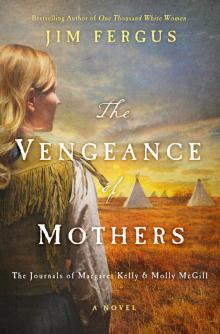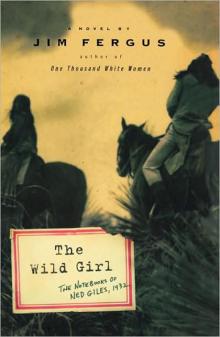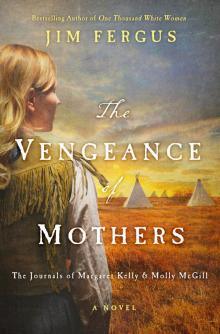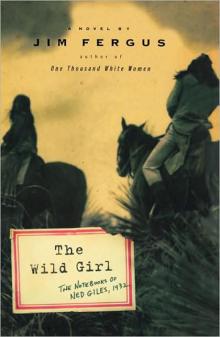- Home
- Jim Fergus
The Wild Girl: The Notebooks of Ned Giles, 1932
The Wild Girl: The Notebooks of Ned Giles, 1932 Read online
THE WILD GIRL
The Notebooks of Ned Giles, 1932
A NOVEL BY JIM FERGUS
To Guy
“I love three things. I love a dream of love I once had, I love you, and I love this patch of earth.”
“And which do you love best?”
“The dream.”
KNUT HAMSUN, PAN
If the ways of seeing in different communities are in conflict because their interpretative practices reflect incommensurable presuppositions about the human situation, can such communities understand each other? Can one culture use its own terms to say something about another culture without engaging in a hostile act of appropriation or without simply reflecting itself and not engaging the otherness of the Other? … Can we ever escape our provincial islands and navigate between worlds?
PAUL B. ARMSTRONG, “PLAY AND CULTURAL DIFFERENCES,”
KENYON REVIEW 13 (WINTER 1991)
Until I was about ten years old, I did not know that people died except by violence.
JAMES KAYWAYKLA, WARM SPRINGS APACHE
IN THE DAYS OF VICTORIO, EVE BALL
Table of Contents
Cover
Title Page
LA NIÑA BRONCA
THE NOTEBOOKS OF NED GILES, 1932
NOTEBOOK I: Leaving Home
LA NIÑA BRONCA
THE NOTEBOOKS OF NED GILES, 1932 NOTEBOOK II: The Great Apache Expedition
LA NIÑA BRONCA
THE NOTEBOOKS OF NED GILES, 1932 NOTEBOOK III: La Niña Bronca
LA NIÑA BRONCA
THE NOTEBOOKS OF NED GILES, 1932 NOTEBOOK IV: Into the Sierra Madre
LA NIÑA BRONCA
THE NOTEBOOKS OF NED GILES, 1932 NOTEBOOK V: Captured
NOTEBOOK VI: Among the Sierra Madre Apaches
NOTEBOOK VII: The Rescue
NOTEBOOK VIII: The Aftermath
LA NIÑA BRONCA
AUTHOR’S NOTE
BIBLIOGRAPHICAL NOTE
READING GROUP GUIDE
A CONVERSATION WITH JIM FERGUS, AUTHOR OF THE WILD GIRL
ABOUT THE AUTHOR
PRAISE FOR JIM FERGUS’S THE WILD GIRL
Also by Jim Fergus
COPYRIGHT
LA NIÑA BRONCA
In the beginning there was Ishtun-e-glesh, White-Painted-Woman. She had no mother or father. She was created by the power of Yusen. He sent her down to the world to live. Her home was a cave.
There was a time when White-Painted-Woman lived all alone. Longing for children, she slept with the Sun and not long after gave birth to Slayer of Monsters. Four days later, White-Painted-Woman became pregnant by water and gave birth to Child of the Water. As Slayer of Monsters and Child of the Water grew up, White-Painted-Woman instructed them on how to live. They left home and, following her advice, rid the earth of most of its evil. White-Painted-Woman never became old. When she reached an advanced age, she walked toward the east. After a while she saw herself coming toward herself. When she came together, there was only one, the young one. Then she was like a young girl all over again.
FROM THE APACHE CREATION MYTH
James L. Haley, Apaches: A History and Cultural Portrait
H. Henrietta Stockel, Women of the Apache Nation
THE GIRL HEARD THE DOGS BARKING LONG BEFORE SHE COULD SEE them, a kind of frantic, high-pitched yipping. She could not know that it was the sound hunting hounds make when they are on a fresh trail. Nor did she have any way of knowing that the trail they were on was her own, that she smelled enough like a wild animal, like the mountain lion they were supposed to be hunting, to temporarily divert them to her path. Yet in the instinctive way that all creatures sense danger in such a sound, and because the barking, though distant at first, seemed to be coming closer, the girl began to run down the arroyo.
The arroyo was dry this time of year and only ran water during the summer monsoons. On the hillsides above grew twisted mesquite trees and gnarled oaks, and above those the tall, straight pines of the high country. Down below, the broad plains were studded with prickly pear and cholla cactus, and impenetrable thickets of catclaw bushes. The arroyo ran to the river bottom, which itself was incongruously lush, a band of pale spring green with grass and ferns, giant cottonwood trees, and white-barked sycamores just beginning to leaf out. To this oasis all things aspired; the wildlife came down to water, and seek shade and cover there. The land itself—the rocky canyons and draws, the folds of land like the knuckles, fingers, and veins on the back of a man’s hand—all spilled into it. Beyond and above, the high jagged peaks of the Sierra Madre rose up, hazy with dust that swirled skyward in the warm spring winds from the plains below.
The girl carried a thin cotton sack containing a few roots she had dug, the only food she had eaten in the several days she had spent wandering the hills and mountains, searching for the People. She wore a two-piece deerskin dress and high-topped moccasins with the distinctive upturned toes of Apache manufacture. The moccasins strapped above her knees, but were now almost worn through at the soles, and a thin rivulet of dried menstrual blood ran down the inside of her thighs, staining the hide of the moccasins dark all the way down to her insteps.
Only a few days before, her costume had been very beautiful, made painstakingly over a period of weeks by her mother for her puberty ceremony, the traditional Apache celebration of a girl’s menarche. The dress was tanned soft and sewn flesh side out, dyed yellow to signify the fertility of pollen and painted with spectacular symbols of White-Painted-Woman, the mother of all Apaches—a rainbow, the morning star, a crescent moon, sunbeams. It was exquisitely beaded and elaborately finished with fringes and silver studs and tin cone-tinklers that once made a light musical tone when she moved. But now the beads and ornamentation were mostly torn off, the dress itself so tattered that the painted symbols hung in shredded ribbons that fluttered as she ran, those few cone-tinklers still attached rattling desolately. And as she ran, the tatters of the dress caught on the grasping thorns of the catclaw bushes, ripping the deerskin away from her slight frame so that she was slowly being stripped naked, her brown flesh where it was exposed to the thorns scored by small cuts and scratches.
It had been a dry spring and scenting conditions were poor for the dogs, which would have been to the girl’s advantage, except that her menstruation gave up the faintest scent trail of blood, permeating the desert air like a vague perfume, further inflaming the hounds. She ran lightly, soundless as a spirit, her feet barely grazing the rocks, silent footsteps raising small puffs of dust from the sandy arroyo, her thick dark hair unbraided and wild, tangled and streaming behind her. She did not breathe heavily, for even though she was exhausted and weakened by hunger she was In’deh, Apache, and could run this pace all day.
The girl did not know what calamitous mistake had been made in her puberty ceremony to bring this terrible disaster down upon the People. She had not gone around with boys before her menarche, which would have disqualified her from assuming the role of White-Painted-Woman. Her aunt Tze-gu-juni, who served as her attendant, had bathed her before dawn on the first morning, washing her hair with yucca root, marking her with yellow pollen down the part of her hair and across the bridge of her nose. Then her aunt dressed her in her puberty costume, starting with the moccasins, then the beautiful dress, during the sewing of which the old woman Dahteste had come to sing the proper songs so that all had been done exactly according to ritual.
But the girl had little time to consider this now, did not think about her mother and her sister as she ran, and of the others dead in the attack upon their camp that morning, did not think about watching from her hiding place in the rocks as three Mexic
an vaqueros raped the women each in turn while the others watched, smoking indolently and laughing. And when they were finished, while her mother tried to comfort her sister in their disgrace, the worst fate that can befall an Apache woman, so that even death was preferable, two of the men had come up behind them with machetes and struck them each a sharp chopping blow to the back of the neck. They fell wailing together to the ground, her mother blindly trying to gather her sister in her arms to protect her from the blows. But the men continued to hack at them for a very long time with the machetes, until they lay still.
Then the men began the task of decapitating the dead with hunting knives, working with the same brutal efficiency with which they might remove heads from the carcasses of game animals. And when they had completed their grim surgery, they mounted the severed heads on sharpened mesquite sticks and rode away to claim their bounties, these In’deh now destined to live for eternity in the Happy Place without their heads.
But the girl did not have time to think about this now. Nor was it a good thing to dwell upon the dead, even worse to speak their names lest you call up their ghosts to bedevil the living. Still, she understood with the innate biological certainty of a species hurtling toward extinction, that Yusen, the life-giver, had abandoned the People, and that somehow she herself had brought this terrible disaster down upon them, that her power as White-Painted-Woman had failed to protect them against their ancient, hated enemies. And so weak and starving though she was, on she ran, steadily, lightly, moving like a spirit being over the rocks, the shreds of her dress fluttering like ribbons, her hair streaming wildly behind her, her soundless footsteps raising small clouds of dust in the dry arroyo.
By the time she reached the river bottom, the sound of the dogs had intensified, their yipping taking on a new resolve. Now the girl spotted the lead dog making his way down the arroyo behind her. He did not look up although he would certainly have seen her, but rather kept his nose to the ground, working a steady, if circuitous route, businesslike, inexorable. The river was low and clear, and the girl ran across on the slick rocks. But she knew that she could not outrun the dog, and partway up the slope on the opposite side, she scrambled up an oak tree and squatted there in the crotch of a branch.
The dog was only mildly confused by her crossing, working up and down the riverbank until he winded her scent and then made his way across on the same rocks. He trailed the girl to the base of the tree, looked up at her finally, in some state of canine puzzlement, growled low in his throat, not quite certain what prey this was. Then he settled himself on his haunches like compressing a spring and pushed off with surprising upward thrust, soaring skyward, as if just to have a better look, his front paws clawing for purchase at the trunk of the tree. But he fell back to the ground, sprawling and ungainly, scrabbling to his feet again, to take up a new tone, a deeper wailing song that told his fellow dogs and the hunter himself that he had brought their quarry to bay.
The hunter, Billy Flowers, had been cutting country for several hours, looking for lion sign when he heard his dogs begin to utter the short choppy bark that told him they had moved a fresh track and were trailing. Flowers knew that his dogs would never trail trash—as deer, or rabbits, or other nonpredatory animals are called by houndsmen. But he could detect a subtle difference in the pack’s barking, a confused edge that suggested they might be tracking something other than a panther. Perhaps, he thought, they had moved a jaguar, although this was a bit north of that cat’s traditional range. Still, it was possible that one had strayed up from the southern Sierra Madre, and he dearly hoped so, for the jaguar was one of the few species that he had not yet killed in his long and distinguished career as a hunter of predators.
Billy Flowers had answered his calling early in life, when the Voice told him to go into the wilds of his native Mississippi and slay the creatures of forest and field. Even after he had grown to manhood, married, and had three children, the Voice would not allow him to rest. And he had no choice but to obey. He finally abandoned his family (although these many years later he still sent money home to his wife and now-grown children) to hunt his way through the south, virtually exterminating single-handedly the black bear in Louisiana before moving on to the canebrakes of Texas. There, in the fall of the year 1907, in the prime of his life, he had served as Teddy Roosevelt’s chief huntsman on a much-publicized two-week bear hunt. A “religious fanatic,” TR had called Billy Flowers in a newspaper account of the presidential safari, simply because Flowers had refused to hunt or allow his dogs to do so on the Sabbath, even though on Monday he had gotten the president his trophy—a lean, immature she-bear, newspaper photos of which gave rise to the nation’s “Teddy Bear” craze.
From Texas, Flowers kept drifting west, looking for open country to wander and varmints to hunt. He eventually settled in the Southwest, though settled was the wrong word. He had no home of his own and spent the better part of the year on the move, living mostly in the mountains with his dogs, only occasionally accepting temporary winter lodgings in the outbuildings of some of the ranchers to whom he contracted his services.
Thus the years had passed, and Billy Flowers became an old man, his hair and beard growing long and white, until he resembled an Old Testament prophet, and a half-crazy one at that, with his searing bright blue eyes. He tallied his kill in notebooks from which, with the hubris typical of many eccentrics, loners, and fanatics, he planned eventually to write his autobiography, under the deluded notion that people would actually be interested in reading about his solitary, violent life as an exterminator of wild creatures. Since he had arrived in the Southwest, he had killed 547 mountain lions and 143 bears. A few years before, he had killed what was very likely the last grizzly bear in the region, a huge, ancient creature, missing two toes off its left front foot, its front tusks worn to the gums. Flowers had tracked the bear for three weeks, from the New Mexico bootheel into the mountains of Sonora and Chihuahua. There he had finally trapped it in a steel-jawed leg trap, which the old grizzly dragged all the way back across the border before Billy Flowers caught up to him and dispatched him. He sent the hide and skull to the National Museum in Washington. The last grizzly bear in the Southwest.
Now, from astride his mule on the ridge above the river bottom, Billy Flowers heard his lead dog, a lanky Walker-bluetick mix named Monk, “barking treed.” He turned the mule, a pale gray named John the Baptist, touched him lightly with his spurs, leaned back in the saddle, and gave him his head, letting the animal pick his own way down the steep rocky slope. John the Baptist was clever and sure-footed, stepping quickly and expertly from rock to rock, squatting low on his rear legs to slide on the loose scree. By the time they reached the bottom of the incline, Flowers heard the other dogs join Monk, taking up the same distinct baying sound that told him, whatever it was, they had the creature up a tree.
He clucked the mule into a run, splashing across the shallow river to find his dogs, all seven of them in perfect biblical symmetry, baying furiously at the base of an oak tree partway up the far slope. The dogs stood on their hind legs, scratching wildly at the tree trunk, alternately leaping and twisting in the air like performing circus dogs, all the while barking and howling their frustrations.
Flowers could not yet make out through the leafy canopy what quarry they had treed, but as he approached he could hear the creature hissing and spitting, and though he knew that it was not a lion, he had no idea what on earth it might be, for it was not a sound he had ever before heard on this earth. He reined up his mule, swung from the saddle, and slipped his rifle from the scabbard. As their master approached, the dogs’ baying became even more frenzied, anticipating the moment that he shot the animal from the tree and they were rewarded for their efforts by being allowed to tear open its gut and feast upon its entrails and organs.
Although Billy Flowers was no longer young, he was still wiry and strong, and he was a man without fear of man or beast. He had wrestled alligators in the swamps of Louisiana, choked the life
from rattlesnakes and water moccasins with his bare hands, killed grizzlies and lions in close combat with a knife. He believed that he had seen just about everything there was to see in the wilds, but he was entirely unprepared for the creature he beheld now in the oak tree, hissing and growling, trying to strike out at his dogs with its hands as if it had claws on the end of its slender fingers. He wondered for a moment if this might be the devil himself, come finally to test him, taking the form of this wild creature, half human, half animal, squatting nearly naked in a tree, shredded clothes falling from its slight body, hair tangled and filthy. The creature had dirty yellow stripes painted crudely on its face, framing eyes black and bottomless as time itself, and filled with a scalding rage as it growled, spat, and swiped at his dogs.
And then with a sense of relief so vague that he hardly noticed it himself, he realized that the creature was not Satan at all, only perhaps Satan’s vessel, a heathen, and a spectacularly unclean one at that. Flowers had been advised when he first came down into Mexico that a small band of wild Apaches still inhabited the hidden canyons and valleys of the Sierra Madre, the high mountain country so rugged and inaccessible that few white men had ever seen it and most Mexicans were afraid to pass there. But Billy Flowers had always traveled alone and feared heathens no more than he did man or beast, of which he considered them to be simply a kind of hybrid. He could see now beneath the rags and the filth that this one was a girl, barely more than a child, and he called off his dogs, who were instantly obedient, quit their baying and began to pace around the base of the tree, panting, slavering, whining, their bony ribs heaving. The girl fell still herself, silent and watchful.
“‘Thou shalt break the heathen with a rod of iron,’” said Billy Flowers in incantation, raising his rifle to his shoulder. “‘Thou shalt dash them to pieces like a potter’s vessel.’” He looked into the girl’s eyes and could find there no hint of fear in her bold, strangely calm gaze, no suggestion even of a shared humanity. It was exactly like looking into the eyes of a lion or a bear, as he had done so many times before in his life in that decisive moment before he dispatched them, their eyes luminescent, impenetrable, casting back only his own reflection.

 La Vengeance des mères
La Vengeance des mères The Wild Girl: The Notebooks of Ned Giles, 1932
The Wild Girl: The Notebooks of Ned Giles, 1932 One Thousand White Women
One Thousand White Women One Thousand White Women: The Journals of May Dodd
One Thousand White Women: The Journals of May Dodd Chrysis
Chrysis Strongheart: The Lost Journals of May Dodd and Molly McGill
Strongheart: The Lost Journals of May Dodd and Molly McGill The Vengeance of Mothers
The Vengeance of Mothers The Wild Girl
The Wild Girl